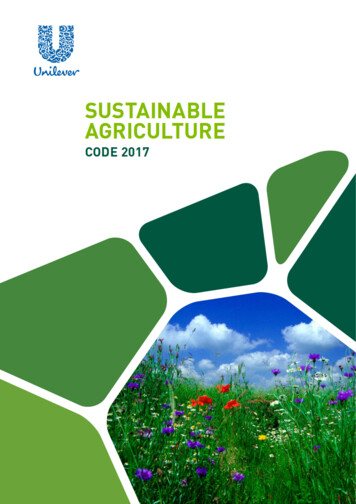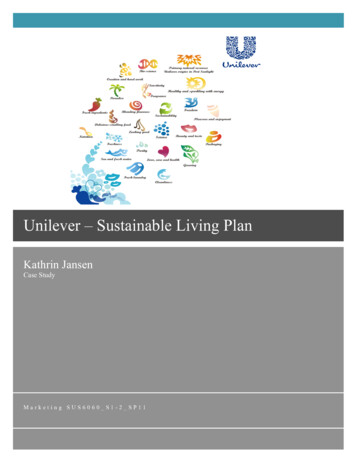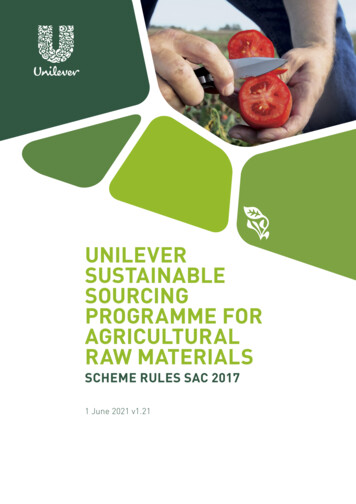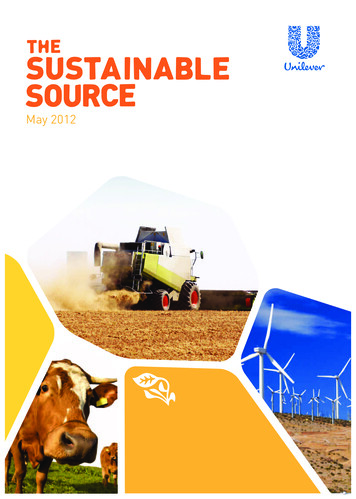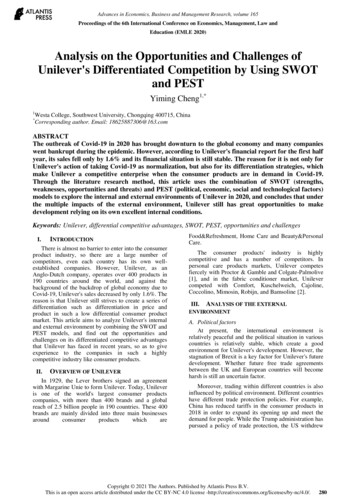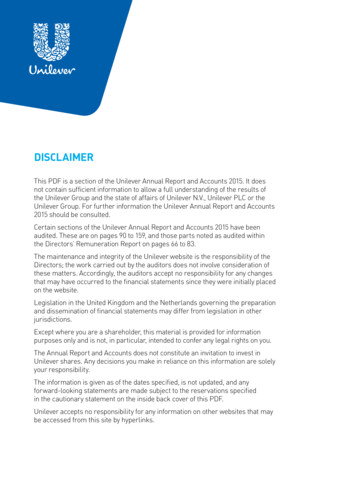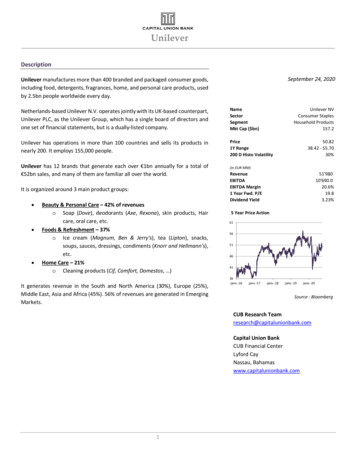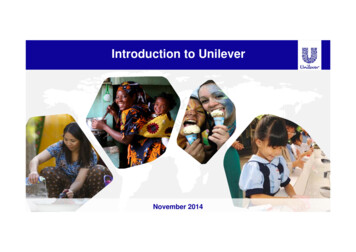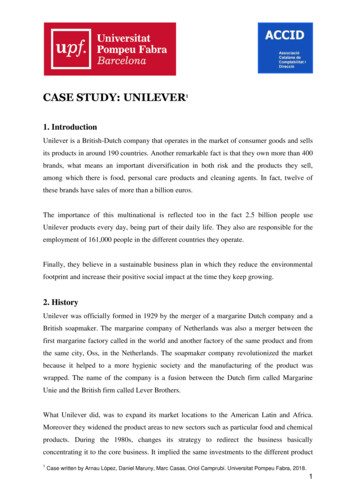
Transcription
UnileverSustainable Agriculture Code
0. General IntroductionContents0.General Introduction 11.Overall continuous improvement 32.Agrochemicals and fuels 33.Soils 144.Water 175.Biodiversity 206.Energy 247.Waste 288.Social and Human Capital 329.Animal Welfare 38Agriculture. With this code, we ask our suppliers, and the farmers who supply them, to adopt sustainable practices10. Value chain & local economy 40on their farms. We expect all our suppliers of agricultural raw materials to commit to joining the sustainability journey11. Training 45over time.Sustainable Agriculture Code - Appendix 1 470.1 Background to the CodeUnilever has always maintained a strong commitment to sustainability. It forms a core part of our company vision todouble the size of our business while reducing our overall impact on the environment. At the same time we continueto serve billions of consumers across the world with products and innovations that help them feel good, look goodand get more out of life. We expect our suppliers to work alongside us to achieve our ambitious consumer andsustainability targets.We believe in sustainable development. The Unilever Sustainable Agriculture Code is our definition of Sustainableand to demonstrate that they agree to minimum standards of performance and to continuously improve performanceThe Unilever Sustainable Agriculture Code covers practices that all our suppliers should strive to achieve. WhereMetrics Sustainable Agriculture Code - Appendix 2 farmers are working with other assurance schemes, our aim is not to duplicate work for farmers. Our code will actas a benchmark and we will only ask for changes in areas where the standard in place and our code are significantly61different.Risk Assessment, HACCP, QA, and TCO Sustainable Agriculture Code - Appendix 3 For example, we are committed to sourcing our Lipton tea bag tea from Rainforest Alliance certified growers, our67palm oil from RSPO certified sources and Ben and Jerry’s ingredients from FairTrade sources. However if for exampleGlossary of terms farmers have found a better solution to increase yield and quality, or reduce pollution, than that listed in our code, weare happy to accept alternative approaches.How was this Code derived?Lead Editors: Unilever Sustainable Agriculture team: Vanessa King, David Pendlington, Dr Christof Walter, Dr Gail SmithBetween 1999 and 2003 Unilever published Good Agricultural Practice documents for our key crops. Over the years,Contributing Editors: Unilever Sustainable Agriculture Community of Practice: Andrea Asch, Samuel Avaala, Klaas Jan van Calker,we realised that while there are clear differences between the management of annual and perennial crops, temperateAlessandro Cruvinel, Dimitris Efthymiopoulos, Fabrizio Fontana, Ximing Hu, Js Kandal, Charles Kumbemba, Anniek Mauser, Sikkeand tropical farming systems and different soils, landscapes and social settings, good farming everywhere has much inMeerman, Zakaria Mitei, Weber Moreira, Jos Van Oostrum, Anandramiah Ramesh. Randy Rickert, Marcelo Rivara; Vijay Sachdeva,common. This collection of sustainable practices has been created and tested by our network of practical agronomistsGabriel Tuei, Jan Kees Vis.and farmers, consultants and sustainability advisers over the last six years and is, we believe, applicable to all ourAdditional contributor: Steve Homer, Biospartners, www.biospartners.co.ukagricultural raw materials.Disclaimer: This document has been discussed with the members of the Unilever Sustainable Agriculture Advisory Board (SAAB).The SAAB is a group of individuals, specialists in agricultural practices or representatives of non-governmental organisationsSupporting documentation(NGOs), who have expertise in different aspects of sustainability. They have agreed to critically assist Unilever in the evolution ofInformation on how Unilever will implement this code with suppliers is available in our “Unilever SustainableSustainable Agriculture Indicators and good practices for a range of raw material crops. The contents of this document and theAgriculture Code Scheme rules”. This document along with Implementation Guides and references is available on:choices made therein are, however, the responsibility of Unilever only.http://www.growingforthefuture.com.Version 1Unilever 2010AcknowledgementsDesign A10plus, Rotterdam, www.a10plus.nlPhotos All the photos are the property of Unilever & the colleaguesthemselves1857For further information/contactSustainable Agriculture Portal: i.unilever.com/sustainableagricultureFor Suppliers: www.GrowingfortheFuture.comPublications: licationsUnilever Sustainable Agriculture Code 1
Sustainable Agriculture Code0.2 Structure of this documentThese Good Practice Documents have been written to establish and maintain a Code for all Unilever suppliers ofagricultural raw materials. The Code is divided into sections1. Overall continuous improvement Introduction Mandatory requirements. Non-compliance with these requirements is unacceptable to Unilever. Good practices. This section addresses suppliers and farmers (see below). Within this section, the words “must”For all sections continuous improvement includes:1.1Continuous improvement must be made by monitoringcompliance with this Code and taking action wheredeviations demand so.Mandatoryrequirement1.2Where a large number of farmers have difficultiescomplying with parts of this Code, or whereimplementation leads to supply issues, this must bebrought to our attention, to ensure we can put into placejoint solutions.Mandatoryrequirementand “should” have been used. They are defined as:Must – A practice that is obligatory, unless there are exceptional circumstances. Any non-compliances must betemporary and addressed in a development plan or agreed as an exception by Unilever.Should - Strongly advised. These actions have the potential to become obligatory requirements (“Must”) in thenext review of this document.Terms defined in the Glossary of Terms (Appendix 3) are in blue.0.3 Scope2. Agrochemicals and fuelsUnless otherwise stated in the text, the scope of this document is as below:Agrochemicals includes both Crop Protection Products (CPPs) and Synthetic FertilisersPractices referring toScopeSoils, soil managementField on which Unilever crops are grown, including fieldsin rotation with other crops.Crop husbandryUnilever cropsAnimal husbandryUnilever animals. Animal slaughter and transport ofanimals off-farm is currently out of scope.People, working conditions, health & safety, trainingWhole farmActivities stretching beyond the farm, such as someaspects of Biodiversity, Water or Value chainWhole farm2.1RecordsUnless specified elsewhere in the text, all recordsmust be accessible and kept for at least 2 years.Records to be kept in this section include:2.1.1(checklist of recordsrelated to this section)1. IPM strategic commitmentMust2. Records to justify agrochemical application:- pest monitoring records for CPPs- nutrient balance calculation for fertilisersMust2.1.33. Agrochemical application recorda) Product nameb) Active ingredient/fertiliser typec) Crop area applied to (including location identifier)d) Ratee) Application datef) Operator nameg) Re-entry period (CPPs only)h) Pre-harvest interval (CPPs only)Must2.1.44. Accident/spillage records and action taken in the eventof an accidentMust2.1.55. Spray equipment maintenance and calibration recordsMust2.1.66. Record of agrochemical store contentsMust2.1.77. Risk assessment record covering all phases ofagrochemical useMust2.1.88. Water quality monitoring recordsShould2.1.20.4 ResponsibilitiesThis Code is applicable to all Unilever suppliers of agricultural goods, the farmers producing them and contractorsworking on farm. We hold our suppliers responsible for implementing this Code. However, many good practices mustbe applied by farmers, not suppliers.2Unilever Sustainable Agriculture Code 3
2.1.99. Training records of applicators and anyone who handles/manages agrochemical productsMust2.3.2.42.1.1010. Details of agrochemical vendors used by the s improvement in this section includes:2.2.1We will actively phase out the use of the most toxic CPPsstarting with WHO Ia and Ib compounds. Unilever suppliersmust develop a phase-out plan for these compounds.Must2.2.2Suppliers should raise awareness of and share knowledge/opportunities for sustainable methods of pest andnutrient management, to ensure we capture best availabletechniques.Should2.3Nutrient Management2.3.1IntroductionWhy this is importantFertilisers and/or composts are important inputs to mostfarming systems, but it is important for both economicand environmental sustainability that nutrients are usedefficiently and not wasted.N, P, K and S inputs need to be provided in balance and inassociation with appropriate micronutrients for maximumuse-efficiency. To do this well, regular soil or tissue analyseswill normally need to be undertaken, and the nutrientcontent of synthetic fertilisers, manures, composts andcrop residues understood. If practical, nitrogen shouldbe supplied locally by legumes grown as part of thecrop rotation or between perennial tree crops and/or byrecycling organic wastes (compost, manure etc.) producedon the farm.Nutrients wasted, and lost to air or water in theenvironment, result in lower profits, acid rain,eutrophication of water bodies, and global warming(greenhouse gas ing progress2.3.2.22.3.2.34Legal complianceProhibitionsWe (Unilever) want to decrease the amount of nitrogenreleased into the environment. Our Sustainable AgricultureMetric “Nitrogen balance” provides a measure of that. Oursuppliers must provide the necessary data for calculatingthis metric.Data requirements for the metrics are outlined inAppendix 1.MandatoryrequirementUnilever suppliers must be aware of and demonstratecompliance with national legal obligations with respect tothe use of crop nutrients.Regulations typically apply to fertiliser purchase, handlingand storage (both synthetic fertilisers and organic manures/composts); amount and timing of application, applicationmode and technology; contamination of fertilisers (e.g.with heavy metals); monitoring heavy metal build up; andprevention of losses to the environment, secure storage toprevent explosives manufacture.MandatoryrequirementUnilever suppliers must ensure that farmers are aware of allnational legal obligations as above.MandatoryrequirementDisposing of fertilisers and/or containers in rivers, streamsor other surface or ground waters is prohibited.MandatoryrequirementApplication of untreated human sewage and humansewage-contaminated water (water from sewers andwater that may be contaminated with runoff from sewagetreatment facilities directly to our crops is prohibited.MandatoryrequirementMust2.3.3Good practices2.3.3.1Ensuring crops get thenutrients they need- the need for a nutrientmanagement systemA crop nutrient management system must be in place,which aspires to optimise all crop nutrient supply, whilstbalancing this with nutrient offtake when the crop isharvested. It is recommended that the Fertiliser BestManagement Practices be developed on a crop and locationspecific basis.2.3.3.2Required componentsof nutrientmanagement systemAs a minimum the rationale for making a nutrientapplication to a crop must include the following:a) Responsibilities must be clearly assigned for planningand carrying out crop nutrition.Mustb) Knowledge of the soil’s chemical, biological andphysical composition must be a basic consideration forthe availability and efficiency of nutrients available tocrops. For example: the soil type and texture (proportionof sand, silt, clay), soil organic matter content, potentialrooting depth (or compaction problems), soil stonecontent, soil parent material and soil pH.Mustc) The nutritional requirements of the crop to reach thedesired yield and quality must be known and translatedinto locally specific operational targets for cropnutrition.Mustd) The amount of Nitrogen (N) - and Phosphorus (P) containing nutrients applied through fertilisers within aseason must be justified by a gap between actual andtarget nutrient supply, taking into account all sourcesof nutrients already available to the crop, includingsoil, previous fertiliser applications, harvest residues,legumes, green manures and cover crops.Muste) A calculation must be made of a simple (input/output)nutrient balance of the crop, using best availableinformation, considering nutrient inputs and nutrientoff-take with the harvested part of the crop.Mustf) Records of the justification (as above) for applyingfertilisers must be made, be accessible, and kept for atleast 2 years.MustUnilever Sustainable Agriculture Code 5
2.3.3.32.3.3.42.3.3.56Recommendedcomponents of nutrientmanagement systemFertiliser applicationIn addition a crop nutrient management system shouldconsider the following:2.3.3.6a) The nutritional status of the crop should be checkedand compared against the nutritional targets. Systemsto detect and diagnose nutrient deficiency or nutrientexcess should be in place, e.g. tissue analysis and/orvisual assessment.Shouldb) There should be a plan for monitoring concentrations ofavailable soil nutrients (specifically any nutrient wherethere is the risk of deficiency or excess supply – see Soilssection).Shouldc) Where nutrient inputs (including those from soilmineralisation, organic nutrient sources) are not equalto nutrients exported in the harvested product, thisshould be explained. Both nutrient mining and excesssupply of nutrients have implications for sustainablecrop production.Shoulda) Fertilisers must only be applied to the intended croparea, specifically avoiding water bodies, wildlifehabitats and places of work or residential areas. Thiscan be ensured by (1) the use of buffer zones; (2) theuse of suitable application technology (e.g. the use ofdeflector plates or spot applications); (3) safe disposalof washings.MustMeasures to avoid N and P being lost to the environmentmust be taken and provided as documented evidence.These include:1) timing of application (e.g. avoid rainy periods,particularly on steep terrain);2) choice of N-fertiliser type (e.g. nitrate-based are lessprone to ammonia loss than urea)3) soil conditions (e.g. ensure soil moisture allows goodinfiltration, avoid frozen, cracked, water-logged orcompacted soils). It is particularly important to keep theN content of soils subject to freeze-thaw and anaerobicconditions in order to limit Greenhouse Gas (GHG)production;4) application technique (e.g. split applications,incorporate or inject organic slurry and urea-basedfertilisers).MustProtecting people andthe environment – Riskassessment2.3.3.7Monitoring of waterquality2.4Pest Management2.4.1IntroductionWhy this is g progressNutrient applications can pose hazards to people (e.g.pathogens) and the environment (e.g. eutrophication dueto nitrate and phosphate losses). A risk assessment shouldbe performed see Appendix 2 covering risks to operators,neighbours/bystanders, consumers, water, soil, air,biodiversity, and GHG emissions.Please note: assessment of risks posed by syntheticfertilisers are covered in the section “AgrochemicalSafety and Risk Assessment” – this section is includedto ensure that manures, sludge and composts are alsoassessed.The risk assessment should consider the following:Shoulda) useShouldb) transportShouldc) storageShouldd) handlingShoulde) contamination, e.g. with pathogens, heavy metals ororganic toxinsShouldf) choice of different nutrient sourcesShouldg) filling, cleaning and maintenance of equipmentShouldh) handling and disposal of packagingShouldWater bodies at risk of being affected by nutrient lossesfrom the farm should be monitored for water quality, andsymptoms of eutrophication investigated.ShouldHealthy crops are the basis of all agriculture. Ensuringthat crops are healthy involves choosing the right cropsand varieties for the location, creating ideal growingconditions and controlling pests (including insects, weedsand diseases), where they threaten to compromise yieldor quality. Integrated Pest Management (IPM) is the key tosustainable pest control.The objective of IPM is to adopt cultural, biological,mechanical, physical and other strategies to discouragethe development of pests in the crop, and by doing so toreduce the need for CPPs.Risks to human health and the environment are minimisedby only using CPPs and other interventions wheneconomically justified, by using less hazardous productswhere these are efficacious, and by adopting safe workingpractices. This means that all people who handle CPPs mustbe properly trained and have access to appropriate PersonalProtective Equipment (PPE), and that all equipment andstorage facilities are well-maintained and secure.We want to reduce the use of hazardous CPPs (WHO classesIa, Ib, II) linked to the production of our raw materials.We also want to reduce the impact of CPPs on aquaticecosystems. Our Sustainable Agriculture Metrics “Chemicaluse” and “Water” provide measures of that. Unileversuppliers must provide the necessary data for calculatingthese metrics.Data requirements for the metrics are outlined inAppendix 1.MandatoryrequirementUnilever Sustainable Agriculture Code 7
2.4.2.2Legal compliance2.4.2.32.4.2.4Unilever requirementsbeyond legislationUnilever suppliers must be aware of and demonstratecompliance with national legal obligations with respect topest management and the management, storage, use anddisposal of CPPs.MandatoryrequirementUnilever suppliers must ensure that farmers are aware of allnational legal obligations as above.MandatoryrequirementWe consider Crop Life International’s Guidelines 1, 2 and 4[‘Guidelines for the safe and effective use of crop protectionproducts’, ‘Guidelines for Personal Protection when usingcrop protection products in hot climates’ and ‘Guidelinesfor the safe transportation of crop protection ations.aspx?wt.ti Publications) as the benchmark. Where they exceedstandards set by national legislation, Crop Life InternationalStandards must be used instead.Mandatoryrequirement2.4.3Good practices2.4.3.1Protecting crops –need for amanagement systembased on IntegratedPest Management (IPM)An Integrated Pest Management System must be in place.2.4.3.2Required componentsof an IPM systemThe IPM system must include the following:Regulations typically apply to: approved CPPs, registrationand choice of CPPs; user protection; re-entry intervals;waiting periods (pre-harvest interval); application rates andtechniques; distance to water courses and no-spray areas;qualification, age and training of operators; handling andstorage of CPPs.(Restrictions on CPP use linked to chemical residues onproducts in the country of consumption are covered in theValue Chain section of this code.)2.4.2.5ProhibitionsAllowing children (under 18 years old) or pregnant ornursing women to handle or apply CPPs.Mandatoryrequirement2.4.2.6Allowing operators to apply/handle CPPs without the basictraining as recommended by Crop Life International1Mandatoryrequirement2.4.2.7Disposing of CPPs, the packaging or containers in rivers,streams or other surface or ground waters.MandatoryrequirementFor specific advice on dealing with obsolete CPPs, seePest Management Implementation Guide or Crop LifeGuidelines.2.4.2.82.4.2.92.4.2.1018Strategic commitment2.4.3.3Re-using CPP containers for any purpose other thanrecycling (i.e. where a proprietary container is refilledprofessionally by the vendor).MandatoryrequirementApplying banned CPPs or making an illegal CPP application.(An illegal application means any application outside of thelabel instructions, application of expired CPPs and use ofCPPs that are not covered by local legislation waivers, forexample off-label applications in minor crops). Banned CPPsinclude products forbidden by local legislation as well asthose covered by global bans, e.g. the Montreal Protocol onozone-depleting substances (includes methyl bromide) andthe Stockholm Convention on Persistent Organic Pollutants(POPs).MandatoryrequirementA strategic commitment to Integrated Pest Managementmust be made, documented in writing (e.g. a companypolicy or statement) and implemented in practice.MandatoryrequirementCrop Life International Guidelines for the safe and effective use of crop protection products commendedcomponents of an IPMsystemMusta) Responsibilities must be clearly assigned for planningand carrying out pest control and for implementingIPM.Mustb) Processes and criteria for selecting suitable growingareas, fields rotations and varieties.Mustc) Cultural control of pests within the agricultural systemto prevent build-up or survival of inoculums.Mustd) Key pests must be identified, their life cycle understoodand action thresholds established2.Muste) Actual infestation levels with key pests in the field mustbe checked and compared against the action threshold,following an appropriate sampling method.Mustf) Any use of CPPs must be justified as essential forachieving the yield or quality we require, or for thatof other crops in the rotation. For key pests, actionthresholds serve as a justification.Mustg) Infestation levels and control measures taken must bedocumented.Musth) A requirement to take into account environmental andhuman health risk where there is a choice of differentCPPs.Musti)MustThe farmers/operator must be supplied, by the customerfor the crop, with a list of preferred CPPs for use in thecrop.In addition, an Integrated Pest Management system shouldinclude the following elements:a) Minimising resistance to CPPs by rotation of activeingredients with different modes of action.Shouldb) Actively managing beneficials and antagonists to reducepest pressure.Shouldc) Using biological or physical controls before using (and/or in combination with) CPPs.Shouldd) Establishing and using action thresholds for pests thatdo not fall under the definition of key pests.ShouldNote: for weeds, where action thresholds are not conventionally used in practice, the expectation is that rational decisionmaking is in place, based on an understanding of the potential impact of weeds throughout the crop cycle.Unilever Sustainable Agriculture Code 9
2.4.3.4CPP application –general requirementsCPPs must be applied in accordance with the requirementsof the label.Must2.4.3.5Prior to application of a CPP, the person responsible for pestmanagement must check if the selected CPP is suitable andlegally approved for the intended purpose.Must2.4.3.6Prior to application of a CPP, the user must check whatsafety precautions need to be observed.Must2.4.3.7Care must be taken that only the intended target area isexposed to CPPs. This can include (1) the use of bufferzones; (2) not spraying at wind speed greater than 5m/sec; (3) the use of low drift technology, spot applications orseed treatments.MustExpired CPP concentrate, sprayer washings, containers,coated seed and any other contaminated material from CPPuse must be disposed of safely or recycled safely.Must2.4.3.9There must be procedures in place to deal with accidentsand spillages of CPPs.Must2.4.3.10Application records must be made, at time of applicationMust2.4.3.11The application records must be traceable back to the fieldtreated and contain at least: the reason for applying theCPP; time of application; product or active ingredient name;and amount applied.MustIf CPPs are used preventively it should be demonstrated thatit is the only economic control option and that it poses nohigher risk to the environment and human health comparedto curative applications.Should2.4.3.13If chemical soil fumigation is used it must be demonstratedthat it poses no higher risk to the environment and humanhealth compared to other control measures.Must2.4.3.14If aerial spraying is used it must be demonstrated that itis the only economic control option and that it poses nohigher risk to the environment and human health comparedto ground based applications.Must2.4.3.82.4.3.122.5Agrochemical Safety and Risk Assessment2.5.1Good practices 2.5.1.1Protecting people andthe environment – RiskAssessmentAgrochemicals can pose hazards to people (e.g. skinirritants, dust inhalation, fire/explosion) and theenvironment (e.g. effects on non-target organisms,eutrophication). A risk assessment must be performedsee Appendix 2 covering risks to operators, neighbours/bystanders, consumers, water, soil, air, biodiversity, andGHG emissions.2.5.1.210CPPs specificapplicationsRequired componentsof the risk assessment2.5.1.3Recommendedcomponents of the riskassessmenta) contamination of synthetic fertilisers e.g. with heavymetals.ShouldIf the risk assessment or any label instructions requirepersonal protective equipment it must be provided and fitfor use.Must2.5.1.5For all agrochemical applications, operators must knowwhat protective equipment to use and how to use it.Must2.5.1.6Full label details for agrochemicals must be accessible tooperators when using or handling agrochemicals in such away that they can understand and apply it.Must2.5.1.7Washing facilities must be available and used afterhandling or use of agrochemicals or any items that couldhave been in contact with agrochemicals, such as PPE oragrochemicals containers.Must2.5.1.8If PPE is used it must be cleaned after use and washedseparately from other washing. Washing must not becarried out by children under 18 years old or by pregnant ornursing women.Must2.5.1.9PPE must be stored separately from agrochemicals andaway from other clothes or household items.Must2.5.1.10Any health and safety risks from agrochemical applicationsto bystanders and members of the local community mustbe avoided. (For example: Taking into consideration wherepublic access points are, observing re-entry intervals, usingwarning signs and using buffer zones around the crop tominimise exposure to the public and livestock.)Must2.5.1.4Human health andsafety requirementsNote: Medical examinations related to agrochemical use aredealt with under the Social and Human Capital section.2.5.1.11Labels, packs andvendorsAll agrochemicals must be purchased in the manufacturers’original containers or packaging (which have not had sealstampered with and are not leaking) with the original labelin a relevant language, with all details on the label legible.Must2.5.1.12VendorsAgrochemicals must only be purchased or supplied bynationally approved or industry-recognised vendors,who supply products of known active ingredient qualityor nutrient content in the proprietary containers, withappropriate storage and delivery facilities.MustDetails of agrochemical vendors used by the farmer must berecorded giving business and agrochemical storage locationand up-to-date contact details.MustAgrochemical containers must never be used to store food,water or feedMustAgrochemical waste stores should not be combined withnew-material storesShouldCPP containers must be reused only for the same chemicalproduct and only when specifically intended and correctlylabelled for continuous reuse.Must2.5.1.17CPP containers must be returned to suppliers wherever thiscan be arranged.Must2.5.1.18CPP containers must be triple-rinsed and punctured or cutapart (to avoid them being used for water or food) beforedisposal.MustMust2.5.1.132.5.1.14The risk assessment must consider all of the following:a) useMustb) transportMustc) storageMustd) handlingMuste) choice of agrochemicals and equipmentMustf) filling, cleaning and maintenance of equipmentMustg) handling and disposal of agrochemical packaging or anycontaminated materialMustThe risk assessment should also consider:Agrochemical waste(generic)2.5.1.152.5.1.16Agrochemical waste(CPP specific)Unilever Sustainable Agriculture Code 11
2.5.1.19Agrochemical waste(synthetic fertiliserspecific)If synthetic fertiliser packaging cannot be reused safely itmust be disposed of responsibly, ideally through specialisedwaste handlers.Must2.5.1.20Off-farm waste disposalAgrochemical waste disposal off-farm must take placeusing contractors who have legal approvals to handle thetypes of waste involved.MustConsignment notes or other documentation should be usedto confirm transfer of agrochemical wastes to contractors,and the dates, volumes and types of waste disposed of.Should2.5.1.21122.6Agrochemical and Fuel Storage and Equipment2.6.1Good practices2.6.1.1Equipment andmaintenance2.6.1.9Agrochemical storageAgrochemicals must be stored safely and correctly.Specifically:a) Any storage facilities must be constructed of suitablematerials, kept dry and well ventilatedMustb) Agrochemical stores must be constructed and locatedin such a way as to minimise risks to people or theenvironment, including during emergencies such as fireor flooding.Mustc) Agrochemical stores must be kept secure. Storagefacilities and any items that could be contaminatedwith agrochemicals must be locked to prevent access bychildren and any unqualified persons.MustApplication equipment must be maintained in goodworking order and safe to use.Mustd) Fertilisers must not be stored together with CPPs or fuel.Must2.6.1.2Agrochemical application equipment must be checkedbefore and cleaned after use.Muste) A record of all agrochemicals currently in the store mustbe keptMust2.6.1.3Agrochemical application equipment must deliver thedesired flow rates and allow for even distribution, bothwithin defined tolerances:- As per fertiliser application equipmentrecommendations for fertilisers- As per Crop Protection equipment manufacturers’recommendations for CPPs.Mustf) Areas where agrochemicals are handled or whereequipment
Sustainable Agriculture Code - Appendix 1 47 Metrics Sustainable Agriculture Code - Appendix 2 61 Risk Assessment, HACCP, QA, and TCO Sustainable Agriculture Code - Appendix 3 67 Glossary of terms 0. General Introduction 0.1 Background to the Code Unilever has
